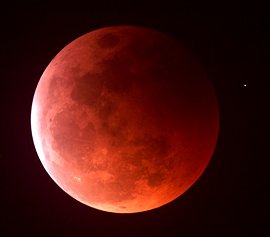The final lunar eclipse of the year will occur today Dr. Chandana Jayaratne, Senior Lecturer in Physics, University of Colombo said a bright red, soft turquoise, total lunar eclipse is visible on Saturday, December 10, full Moon day midnight. This is not only the last eclipse of this year but also the last total lunar eclipse visible to the world until 2014 Dr. Jayaratne said.
 Dr. Jayaratne further said the eclipse begins at 5.04 p.m. on 10th evening with the Moon entering into the penumbra of the Earth's shadow (less dark shadow) and ends up at 11.00 p.m. Sri Lanka standard time on Saturday (10) night. The visible part of the eclipse for the observers begins around 6.16 p.m. with the moonrise from the eastern skies when Moon enters into the Umbra - the dark part of the Earth’s shadow and the eclipse will appear till the Moon leaves the Umbra at 9.48 p.m. The total eclipse (i.e. the Moon is fully covered by the dark shadow of the earth) is visible for a period of 51 minutes from 7.36 p.m. till 8.27 p.m. with the greatest eclipse occurring at 8.02 p.m. The entire event is visible from Asia and Australia .
Dr. Jayaratne further said the eclipse begins at 5.04 p.m. on 10th evening with the Moon entering into the penumbra of the Earth's shadow (less dark shadow) and ends up at 11.00 p.m. Sri Lanka standard time on Saturday (10) night. The visible part of the eclipse for the observers begins around 6.16 p.m. with the moonrise from the eastern skies when Moon enters into the Umbra - the dark part of the Earth’s shadow and the eclipse will appear till the Moon leaves the Umbra at 9.48 p.m. The total eclipse (i.e. the Moon is fully covered by the dark shadow of the earth) is visible for a period of 51 minutes from 7.36 p.m. till 8.27 p.m. with the greatest eclipse occurring at 8.02 p.m. The entire event is visible from Asia and Australia .
The Astronomical Research Center (A.R.C) mentioned that a lunar eclipse occurs when the Earth's shadow falls on the Moon. This can only happen on a full Moon night when the Sun is on one side of the Earth and the Moon on the opposite side. If these three celestial bodies get aligned in straight line on a single plane, a lunar eclipse occurs. The Earth’s shadow has two parts - umbra and penumbra. Umbra is the main dark shadow of the Earth, while penumbra is a semi dark shadow (brighter than the umbra) located around the umbra.
Darkness of the total lunar eclipses of this type is used as a measure of Earth’s atmospheric pollution. The light rays from the Sun get scattered by dust particles in the Earth’s atmosphere to produce a somewhat reddish tint to the Earth shadow giving a brownish-red colour to the eclipsed
The lunar eclipse can be viewed by naked eye and using telescopes as well Dr. Jayaratne stated.